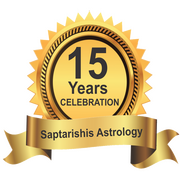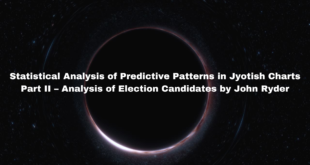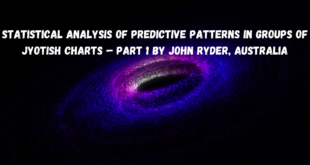Related Articles
‘Thandava Malai’ was compiled by a scholar ‘Shri. Thandava Bhoopathy’, who was a prime disciple of Shri. Appavu Aiyar, a renowned astrologer. Shri.Appavu Aiyar was a disciple of Shri. Govinda Dheekshita, thus goes the Guru Parampara. The worthy disciple has compiled his master’s teachings in verses and named after the book by his name. This book is rich in content and lucid in style. The verses resemble some verses of Brihat Parasara Hora as well as Udu Daya Pradeepika. The author Shri. Thandava Bhoopathy is a Sakthi Upasaka. His son Shri. Kacchhalai Murthy was also a famous personality. Nothing could be ascertained regarding the period of the text. Roughly, considering the style of the verse, this text might not been written earlier than 17th century.
Continued From Previous Edition
17.“Even (functional) malefics are capable of bestowing yoga results to any individual, (during their dasa‐bhukthis) according to their own strength, ownership and relationship with other (functional) benefics”
As already Thandavarayar has explained the functional nature of planets sufficiently in the earlier verses supra, here by calling ‘malefics’, he is addressing those planets which are not owning any angular / trinal houses for the ascendant, in question. They may be summarized as below:

According to this verse, even the above said malefics are capable of conferring good to the native, if they are establishing any relationship with functional benefics.
The author has succinctly defined the terms to assess the quantum of beneficence (yoga‐phal) that can be generated by any planet, in the earlier verses themselves. Accordingly they may be categorized as below in the descending order of that beneficence.
- Perfect Yogakaraka viz. single planet owning both angle and trine and Rahu or Ketu when posited in trine.
- A planet owning a trine simultaneously possessing a neutral lordship, but favorably disposed.
- A planet owning a trine simultaneously holding a Trishadi Lordship, but favorably disposed.
They may be tabulated as below, so as to cater to the need of better understanding of verse 19 infra also.

- Rahu / Ketu is a perfect yogakaraka when posited in a trinal house. Here, it is to be noted that both the nodes can never be in trines simultaneously.
Coming back to this verse, it can be summarised as below:
- The directional influences of any planet mentioned in Table‐I is good to the native inspite of its maleficence, provided such malefic should establish any relationship/association with the corresponding yogakaraka mentioned in the Table‐II.
- The quantum of such benefit will be in congruence with the status of the benefic which establishes relationship in Table‐II in the descending order from columns (i) to (iii). For example, for a Taurus Ascendant let us consider Jupiter establishes relationship with Saturn (9, 10 th) then the Jupiter’s Dasa or Bhukthi will be favorable to the native inspite of its Trishadi Lordships. Similarly, any relationship by Jupiter with Mercury (2, 5 th ) or Venus (1st, 6th) will also infer favorable directional influences of Jupiter. But, the difference is in benefit quantum in descending order, viz. Saturn, Mercury and Venus respectively.
The author has very carefully utilized the phrase ‘vayangu posippirkerpa’, which
inherently conveys that the rulership of those planets should not be overlooked in tune with the basic canons of astrology.
For example, let us consider a Leo native whose Mercury associated with Jupiter. Then whenever the individual undergoes the directional influences of Mercury, he can reap very good financial prosperity as Mercury is the Lord of 2 nd and 11 th . But, at the same time Mercury’s association with Jupiter (being 8 th Lord also) will have its own evil potential. Therefore, the individual may have to face severe strain, accidents, struggles, etc. also duringthe Mercury’s Dasa, Bhukthi and Antara.
The efficacy of this verse can be verified with the following case study. This is the chart of Dr. Rajendra Prasad.

(Source: Chart No.53 of Notable Horoscopes by Dr.B.V.Raman).
It was during the Moon (8th Lord) bhukthi of Mercury Dasa he was elected as the First President of the Indian Republic. The bhukthinath Moon has conferred Raja Yoga, inspite of its being randhresh to Sagittarius Ascendant. Note that the exalted Moon (malefic vide Table‐I) was aspected by 9th Lord Sun (Rajya Karaka and shown as Second degree yogakaraka for Sagittarius in Table‐II) and thereby generated a powerful Raja Yoga. Of course, Moon being 8 th Lord in 6 th indicates a Vipareeth Rajayoga, which is always favorable for political pursuits. Hence, this Chart is the perfect explanation of Verse 17 of Thandavamalai
“If either of the nodes is deposited in an angle or a trine and establishes relationship with the Lord of any other trine or angle than its original dispositor, then the periods of that node will confer unblemished yoga”
18.As mentioned by Thandavarayar in verse 11 supra, being Chaya grahas without any sign ownership, Rahu and Ketu are fully dependant on their positional strength. Considering this fact as base, the author has composed this verse. The three conditions stipulated in this verse may be substantiated as follows:


(Source: Chart No.70 of Notable Horoscopes by Dr.B.V.Raman).
This is a chart of an internationally reputed scientist. In this chart, mark the disposition of Rahu in 1 st house, which is a Trine‐cum‐Angle. Hence, it itself is a fine placement. In addition to this, his association with Mercury, which is a second degree yoga‐karaka for Libra natives (vide Table‐II supra) makes Rahu an absolute yogakaraka. Let me reproduce the comments of Dr. B.V.Raman on the Rahu Dasa of the individual in the Notable Horoscopes as “ . . . . . it was only during Rahu dasa that the official position of the native was built up until he reached the present enviable position of all‐India importance. . . . .
Rahu conferred on the native great name and fame as scientist of international repute and gave wide travelling all over the world, great distinction, respect and responsibility.” This case study stands as testimony for the efficacy of verse‐17 of Thandavamalai.
19.“When a planet holds ownership of both a trine as well as an angle, undoubtedly it confers yogaphal to the native. Further, if it conjoins with any other trinal lord, how can I measure the austerity of that planet?”
This verse is a consummation of principles propounded in verses 12 to 15 supra. The real intention of the author for repeating the concept is to reinforce the basic canons of astrology.
Angles are known as Vishnusthanas and Trines are known as Lakshmisthanas as per shloka 43 (28) of Brihat Parasara Hora Sasthra. Association of these Lords infers that the native can reap both spiritualistic as well as materialistic pursuits of life during the directional influences of that Lords.
When a same planet plays the dual role of angular and trinal lordship, he represents himself as unblemished yogakaraka to the native. Association of other trinal lord with this lord is still more auspicious. That is why; Thandavarayar has composed this association in an exclamatory form.
In the verse‐16 supra, the author has narrated the beneficent effects of the malefic (in Table‐I) while they are associating with the yogakarakas (in Table‐II mentioned thereunder). Now, in this verse, he has narrated the propitious results of yogakarakas (mentioned in Table‐II alone). Firstly, he has praised the austerity of Angular‐cum‐ Trinal Lords, which are tabulated in column (i) of Table‐II. Next, he has upheld the inter‐relation of perfect yogakaraks (column‐I) with other yogakaraks [Columns (ii) and (iii)] mentioned in Table‐II therein. Obviously, the yogakaraks bestow highest beneficence to the natives during their directional influence.

(Source: Chart No.31 of Notable Horoscopes by Dr.B.V.Raman).
This is the chart of George Bernard Shaw. In this chart, Angular‐cum‐Trinal Lord is Saturn and thereby qualifies for perfect yogakaraka. He conjoins with Mercury another trinal lord. Their association is the major strength of the chart. He won the Nobel Prize for literature in Mercury Dasa. Most of his accomplishments were in the Mercury Dasa. That is why, Dr. B.V.Raman has rightly observed about the Mercury Dasa of Bernard Shaw as “Mercury Dasa commenced in 1923 and Shaw’s reputation reached a climax.” Thus, verse 19 of Thandavamalai has been testified.
20.“The Dharma‐Karmathipas will not confer their yoga results to the individual, if they are simultaneously owning 8 th or 11 th houses also”
We can come across some texts, which are saying that the Dharmakarmathipa Yoga is ineffective for the Aries and Gemini individuals. For Aries natives, Jupiter is the 9 th ‐cum‐ 12 th lord and Saturn is 10 th ‐cum‐11 th lord. 2 Hence, their Dharmakarmathipa Yoga is not
effective. For Gemini natives, Jupiter is the 7th‐cum‐10 th lord and Saturn is the 8 th‐cum‐9 th lord. Hence, their Dharmakarmathipa Yoga is also not effective.
Some astrologers used to say the same thing in a different manner. They mention that the association of Jupiter and Saturn is not conducive to produce any benefic results. They are assigning a peculiar reason also for this as below:
Jupiter and Saturn being the mega‐size planets by volume‐mass,
their association is denoting a strong graha yuddha (planetary war) and thereby depriving both the planets or atleast one as defeated or weak. Therefore, the yoga that can be caused by their association is also feeble. If we extend this principle, the Dharmakarmathipa Yoga of Taurus is also null and void, if Saturn associates with Jupiter.
Though this argument appears to be rational, this is not exhibiting the real astro‐ perspective with reference to the established tenets of astrology. This verse of Thandavamalai alleviates this deficiency, which can be understood as follows:
The houses are classified by the Thandavarayar as four major groups viz. (1,5,9), (1,4,7,10),(3,6,11),(2,12,8) in the initial verses themselves of this text. It was also established that the strengths are progressive in nature within every group. Therefore, 9 th is the strongest in the first group, 10 th in the second, 11 th in the third and 8 th in the fourth groups respectively. While the 9 th and 10 th lords are benefic in nature, 8 th and 11 th lords are malefic in nature. Therefore, the inter‐relationship between these strong benefic and malefic lords (as per prabhalaschothram) is conducive to nullify the beneficence of the Dharmakarmathipa Yoga.
Therefore, in consummate, the effective Dharmakarmathipa Yoga is not at all possible for Aries and Gemini ascendants and ineffective in respect of Taurus, if Saturn associates
Jupiter. For rest of the ascendants, it is ineffective, if 8 th or 11 th lord associates with 9 th or 10 th lords.
21.“The 8 th house and 8 th from the 8 th house (i.e. 3rd house) are the houses of longevity. Twelfth from these two houses (i.e. 7th and 2nd) are Maraka houses”
In the preceding verses, Thandavarayar has explained the nature of various bhavas and modes for ascertaining strength of yogakarakas, and some prominent yogas like Dharmakarmathipa Yoga, etc.
After explaining yoga and yogabhavas, the author has attempted to narrate the ayurbhava from this verse onwards. In order to enjoy the yoga results, one must have sufficient life to live. Therefore, the author has now explained the Maraka effects, etc.
This verse is based on the principle of ‘Bhavat Bhavam’. As we know, 8 th house is the house for longevity and 8 th therefrom reckons to 3rd house. Therefore, 8 th and 3rd houses are the houses for longevity. Again extending this principle with reference to twelfth
from these houses for longevity, we get 7th and 2 nd houses, which are known as Marakasthanas. Here, one natural question arises as to why with reference to twelfth alone taken for deciding Marakasthanas.
The 12 th bhava stands for spending of anything and thereby, 12 th to any bhava destructs the bhava concerned in slow pace. Therefore, 12 th to Ayushthanas are denoting spending of life or destruction of life and fully qualified to become marakas.
Thus, the individual’s longevity can be determined by the strengths of the Ayushthana Lords viz. 8 th and 3rd Lords, whereas the risk of life i.e. maraka effects can be expected during the directional influences of 2 nd and 7 th Lords.
However, in our humble opinion death is a complicated knot. Nobody can untie it without divine will. Moreover, even a competent astrologer will get perplexed to delineate the period of death. That is why; there are umpteen numbers of rules prescribed for ascertaining the maraka period in various texts. This text is also not an exception. That we may see in the subsequent verses.
22.“Among these two Marakathipas (2 nd and 7 th Lords), comparatively 2nd Lord is a powerful Maraka than the 7th . The planets disposited in these Maraka houses as well as that are associated with the Marakathipas are also confer Marakaphal”
In the last verse, the author has defined the two Marakasthanas. Here, he explains further about their comparative strengths. Among the two Marakathipas, 2 nd Lord is stronger in conferring Marakaphal than 7th Lord to any native. This is based on the fundamental nature of bhava lords explained in earlier verses.
Earlier we have seen that the 2 nd Lord is neutral by nature, and 7 th Lord (being a Kendra Lord) is benefic by nature. Therefore, while conferring Marakaphal, 2 nd Lord presides over 7th Lord. Astro results are dependant not only on disposition, but also association. Therefore, the planets associating with 2 nd Lord/House are also holding the sway of Marakaphal.
The word ‘Marakaphal’ does not necessarily imply to ‘death’ alone. Because, for all natives, except Aries and Libra natives, both the Marakathipas (viz. 2 nd and 7th Lords) may hold other rulerships also. Therefore, the marakaphal is subject to modification w.r.t. their other rulership as well as association.
Even if other factors are also supporting, the markathipas not necessarily exclusively imply death. Because, as stated earlier ‘death’ is undoubtedly a mystery. Of course umpteen numbers of methods are available in astro‐texts to assess the longevity of a person. They may point to an outline of a person’s longevity, that too approximately. That is the reason, there is availability of manifold methods in astro‐literature, to assess the longevity of a person.
23.“In the dasa of the planets, that are associated with the maraka houses, the native may face death (or death‐like danger). When the native has no chance to come across the dasa of those maraka planets, then death (or death‐like danger) may be predicted for the native during the 12th Lord’s period”
In the earlier verses the marakathipas were defined. When the individual has no chance to come across dasas of such planets, which are associated with the 2 nd and 7th houses, then the 12th Lord will take hold of such maraka role during its main period.
As stated earlier, the 12 th (vyaya) bhava being the house of destruction of any bhava, destruction of self can be delineated through the 12 th to the Ascendant, i.e. 12th Lord. Vyaya bhava to the Ayushthanas viz. 2 nd and 7 th houses have already been identified as marakasthanas. Next, vyaya bhava to the Ascendant (denoting self) has been qualified for maraka.
In the Vimshottari Dasa System, cyclically many dasas rule the destiny of the native. In that cycle, the dasas of planets associated with 2 nd, 7 th and 12 th houses are empowered to confer marakaphal.
24.“Death may be predicted during the dasas of these (2 nd / 7 th /12th) Lords or during the dasas of the planets deposited in these (2nd / 7th / 12 th ) Houses. If these periods do not prove fatal, predict end during 8 th Lord’s dasa”.
25.“If there is no chance to come across the dasas of planets (that are associated with the 2 nd / 7 th /12 th /8 th houses by ownership or disposition), then the dasas of perfect malefics are dangerous to the life of the native”
26.“If Saturn is associated with Maraka planets (discussed in the preceding verses), he will take the sway presiding over the rest of the planets to cause death ”
From the verse 21 onwards, Thandavarayar has narrated the maraka dasas. They may be serialized as below according to their hierarchy to confer marakaphal:
- The Lords of 2 nd and 7 th
- The Planets deposited in 2nd and 7th
- The Lord of 12 th
- The Planets deposited in 12th
In this list, by 24 th verse, the author has added 8 th house and the planets deposited in 8 th house also to confer marakaphal. Here, 8 th house is not only known as Ayushthana but also as Randhrasthana. Therefore, the planets associated with the 8 th house are also empowered to confer marakaphal.
By 25th verse, the author has added the dasa of perfect malefics also in the list. If the native has no chance to come across all the above dasas, which is quite rare, then the perfect malefic of his ascendant will take the sway to give death during its dasa. The list of perfect malefics for each ascendant is presented in Table‐I under verse 17 supra.
In the 26 th verse, Thandavarayar has substantiated the role of Saturn in causing death. As he is the significator of death, when associated with any maraka planets discussed in the verses 21 to 25 supra, Saturn will automatically taking precedence over other planets to end the life of the native. Here, when Saturn doesn’t associate with any maraka planet then such Saturn is not empowered to cause death. There is a view among astrologers that any significator in the significatory house will destroy that bhava i.e. karako bhavanasthe. But, Saturn is an exception to this rule. That is Saturn will not kill the native, even though he is in the 8 th house. This is supported by the following shloka of Brihat Parasara Hora Shastra:

Shloka 46(9) of BPHS
In this shloka, emphasis is given on the words ‘papakrichani’ (ill‐disposed) and ‘marak griha sambandhanni’ (associated with Marak planets) in order to mention them as prerequisite conditions to declare Saturn as Maraka.
In consummate, for any horoscope, the qualified planets to bestow marakaphal during their dasas are many. That is what the verses 21 to 26 of Thandavamalai speak. But, then how to delineate the period of death accurately? To our humble opinion, this is the area wherein the Brahmalipi (i.e. the destiny of the native) is under perfect mystery. Time and again, we wish to insist upon this point.
However, besides some specific combinations regarding longevity, some methods are prescribed by various classics to ascertain the longevity like Pindayu, Amsayu, Naisargika Ayu, Jeevayu, Mishrayu, Jaimini method, etc. Readers may refer to these methods and then the life‐span of the native be classified as Short or Medium or Full.
According to this classification, the dasa period discussed above be correlated to arrive at the best of the judgment.
27.“The Dasanath, whoever may be, will not confer fruits according to his own nature during his own Bhukthi (Swabhukthi)”
From the verse 27 onwards, Thandavarayar has narrated the nature of Dasa‐Bhukthis. The Lord of the main‐period will not confer fruits to the native according to his swabhava (own nature) during his sub‐period.
Normally, the course of the life or life‐events could not be compartmentalized according to the ruling planets of the individual. Because, life‐events of any native are not subject to change over‐night. Life is like an evolution and not as revolution. Rarely, some unexpected happenings may suddenly alter the life course of the individual, for which there should be strong yoga/avayoga in support of such happenings.
Hence, the impact of the earlier dasa’s end bhukthi (known as dasa‐chidra in astrological parlance) will be felt in the subsequent dasa’s starting bhukthi. This is what this verse conveys. Therefore, the originality of the operating Dasa could not be noticed in its first Bhukthi (i.e. his own sub‐period). But, when the Dasa Lord himself involves in a strong Yoga/Avayoga, then the favorable/unfavorable results of the Dasa Lord could be felt in his Swabhukthi itself. In order to explain this case, the author has reserved some of the subsequent verses.
In this verse, the ‘nature’ of the Dasa Lord stands for his status such as yogakaraka, maraka etc.
To Be Continued …..
Learn Astrology: Join our upcoming Course – Click Now
Learn Astrology : Join Our recorded Course – Click Now
 Saptarishis Astrology Magazine Into Creating Astrologers
Saptarishis Astrology Magazine Into Creating Astrologers






